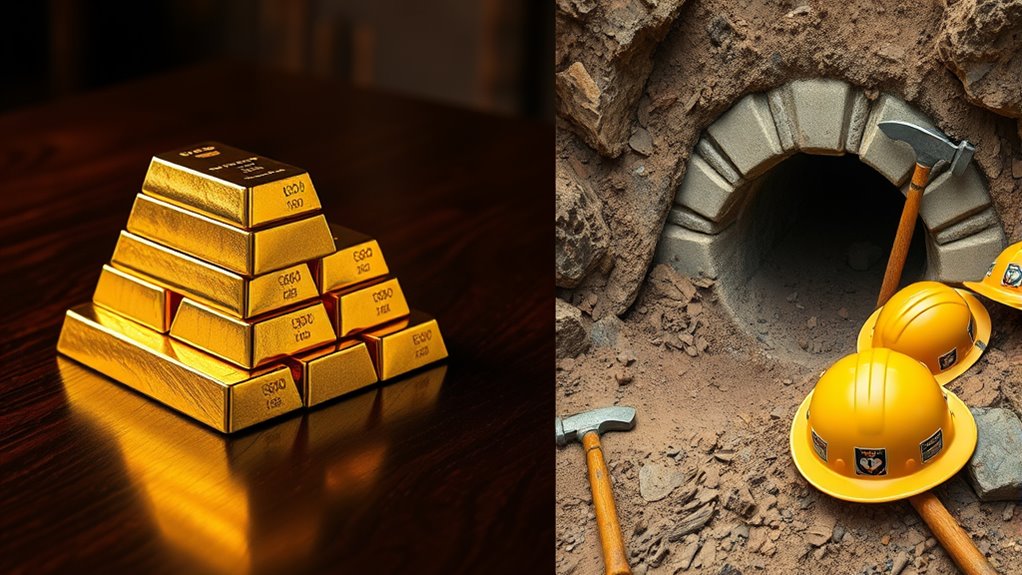When choosing between gold miners and physical gold for your IRA, consider that physical gold provides stability, lower volatility, and acts as a safe haven during economic crises. Mining stocks can offer higher growth potential and dividends but come with greater risks and price swings. ETF options are easy to buy and sell, but storage and insurance add costs for physical gold. Understanding these differences helps you decide which aligns best with your retirement goals—more insights await.
Key Takeaways
- Physical gold offers stability and lower volatility, making it a safer store of wealth in IRAs during economic downturns.
- Mining stocks may provide dividends and potential for higher growth but carry greater operational and market risks.
- ETFs and mining stocks are more liquid and easier to buy or sell within IRAs compared to physical gold, which requires secure storage.
- Physical gold has no default risk and can serve as a reliable long-term preservation asset, especially in times of crisis.
- Mining stocks’ performance is influenced by company management and operational factors, often decoupling from gold’s overall market trend.

Are you trying to decide between investing in physical gold or gold mining stocks? Both options offer exposure to gold’s value but come with distinct advantages and risks, especially within an IRA. Over the past decade, physical gold has markedly outperformed major gold mining stocks. Gold prices have risen about 55%, while the GDX ETF, which tracks gold miners, only gained around 12%. In the last five years, gold surged roughly 95%, whereas top miners like Newmont and Barrick lagged behind, posting gains of just 1.6% and -11%, respectively. This performance gap highlights that, despite gold rallies, mining stocks often face operational headwinds—rising costs, geopolitical risks, labor issues, management errors, and environmental liabilities—that cut into profitability. Even during periods of strong gold prices, mining stocks may struggle to keep pace.
When it comes to volatility, physical gold presents a more stable profile. Its price tends to fluctuate within a narrow range, offering a safer haven during economic uncertainty. In contrast, gold mining stocks are more volatile, with larger swings driven by company-specific factors like operational efficiency, cost management, and market sentiment. Gold’s intrinsic value and near-zero default risk make it a reliable store of wealth, especially in turbulent times. Mining stocks, however, carry the risk of becoming worthless if a company encounters severe financial trouble or fails operationally. This risk profile makes physical gold a more dependable safe-haven asset, particularly in periods of stagflation or economic crises when gold traditionally outperforms equities and mining stocks.
While gold mining stocks may offer dividends, these are not guaranteed and depend on company profitability and management decisions. Physical gold provides no yield or interest; your return hinges solely on price appreciation. If a miner remains profitable, it might pay dividends even if gold prices stagnate or fall, but this isn’t assured. Reinvesting dividends from mining stocks can boost returns, but owning physical gold doesn’t offer that benefit directly. Regarding taxes and liquidity, ETFs and mining stocks are generally more liquid and easier to buy or sell on exchanges. Physical gold, especially in an IRA, requires secure storage and insurance, increasing holding costs. Storage and insurance considerations also influence the overall cost and practicality of holding physical gold. Tax rules differ for physical gold as a collectible versus securities, but both can benefit from tax-deferred growth within an IRA.
Ultimately, physical gold’s value is driven by global demand, inflation, and safe-haven flows, making it less dependent on operational performance. Mining stocks, while influenced by gold prices, are also affected by company management and market sentiment, which can decouple their movement from gold itself. Since 1971, gold has appreciated about 8% annually in USD, but mining stocks tend to be undervalued by analysts, often not fully pricing in future gold price rises. This makes physical gold a more stable, reliable option for long-term preservation within an IRA, especially for those prioritizing safety and consistent performance.
Frequently Asked Questions
How Do Gold Miner Stocks Perform During Economic Downturns?
Gold miner stocks often perform poorly during economic downturns because they’re tied to broader economic health. When the economy slows, demand for gold and mining profits decline, leading to falling stock prices. However, some investors see miner stocks as a way to leverage gold’s potential upside, but they carry higher risk and volatility. You should weigh these factors carefully and consider your risk tolerance before investing in gold miners during tough economic times.
What Are the Tax Implications of Investing in Physical Gold?
Did you know that physical gold held in IRAs can be taxed differently depending on how you take distribution? When you buy physical gold, you might face a 28% IRS excise tax if not held properly, plus potential capital gains tax upon sale. If you prefer to avoid hefty taxes, consider storing gold in a qualified depository and consulting a tax professional to optimize your tax position.
Can Gold Miners Be More Volatile Than Physical Gold?
Yes, gold miners can be more volatile than physical gold. When you invest in miners, their stock prices often fluctuate due to company performance, operational risks, and market sentiment. These factors can cause larger swings compared to the relatively stable value of physical gold, which simply tracks gold’s price. So, if you’re seeking stability, physical gold might be a better choice, but miners could offer higher growth potential with added risk.
How Does Inflation Impact Gold Mining Stocks Versus Physical Gold?
Ever wonder how inflation hits your investments differently? When inflation rises, physical gold often holds its value, acting as a safe haven. Gold mining stocks, however, can soar or plummet depending on factors like commodity prices and company performance. So, while physical gold shields you from inflation’s immediate impact, mining stocks might offer higher gains or greater risks. Choose wisely based on your risk appetite and inflation outlook.
Are There Specific Regulations for IRAS Holding Gold Miners?
Yes, there are specific regulations for IRAs holding gold miners. You must guarantee the gold mining stocks or funds comply with IRS purity standards, typically 0.995 fine gold or equivalent. Your IRA custodian must be approved for precious metals investments, and all holdings must be stored at an IRS-approved depository. You can’t hold physical gold or stocks directly in a regular IRA without proper setup.
Conclusion
Ultimately, choosing between gold miners and physical gold depends on your goals and risk appetite. Miners can offer leverage and growth potential, but come with higher risks. Physical gold provides stability and tangibility, though it may lack growth. Remember, “A penny saved is a penny earned,” so weigh your options carefully to protect your retirement. Whichever path you choose, diversify wisely and stay committed to your financial future.








